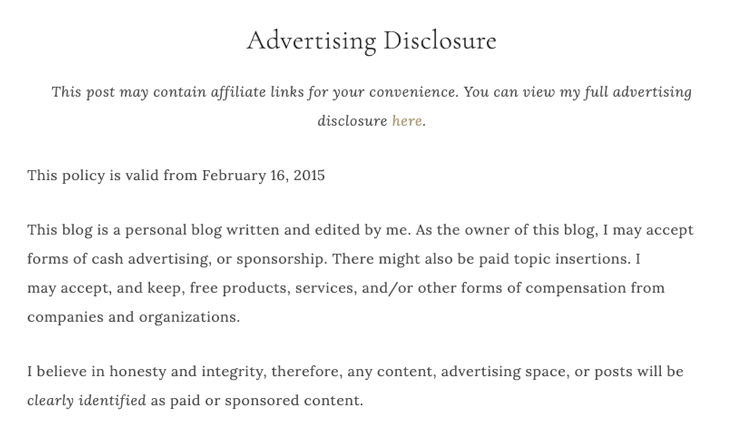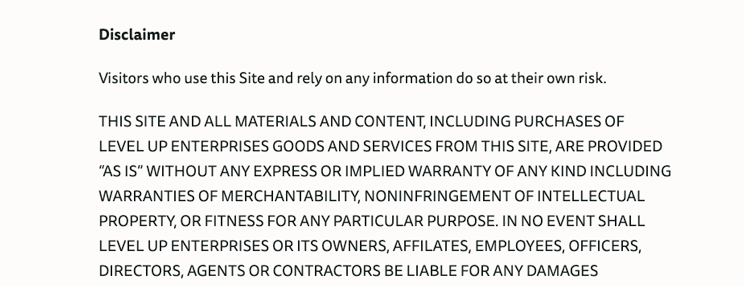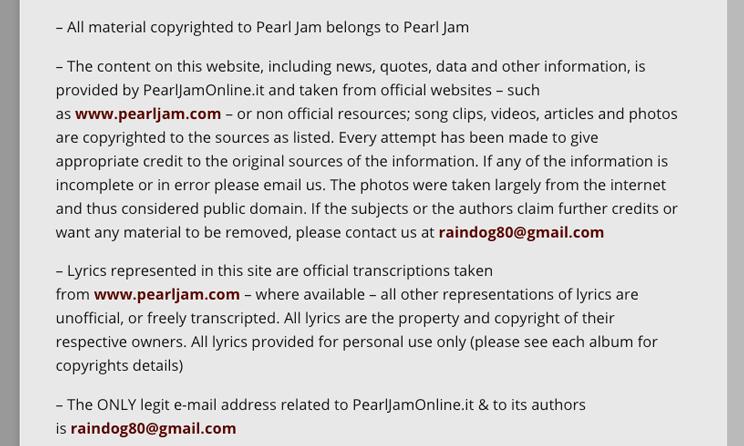How To Write A Disclaimer For A Blog
A blog disclaimer is a statement that warns users to act on your content at their own risk, or alerts readers to important information, such as your relationship with affiliates.
For many blog owners, well-placed disclaimers can help limit liability. Learn more about the most commonly used blog disclaimers and how to write your own.
- Blog Disclaimer Examples
- Affiliate and Advertising Disclaimer for Blog
- Medical Disclaimer for Blog
- Health Blog Disclaimer
- Copyright Disclaimer for Blog
- How to Write a Blog Disclaimer
- Blog Disclaimer FAQs
Blog Disclaimer Examples
There are many types of disclaimers to include on a blog. Which ones you may need will depend on your activities and content.
For example, you need to add an affiliate disclaimer to any post that contains affiliate links, while you may need a legal disclaimer in your blog's footer if any of your content can be construed as legal advice.
Let's look at the most common examples of blog disclaimers:
Affiliate and Advertising Disclaimer for Blog
The Federal Trade Commission (FTC) requires blogs that include affiliate links or sponsored content to prominently post an affiliate disclaimer.
FTC guidelines require bloggers to disclose whether they receive compensation for using affiliate links, reviews, testimonials, or rankings of products.
The blog Lemons, Lavender, and Laundry's advertising disclosure reminds readers of a couple of important things:
- The blog owner accepts cash advertising and sponsorships, which can include free products.
- The blog owner will always clearly identify this type of paid or sponsored content.
- Lemons, Lavender, and Laundry stands fully behind all the products it recommends, despite any receipt of a commission.

When you're writing an advertising or affiliate disclosure for your blog, consider including these points:
- A reminder that you may use affiliate links or accept compensation for products.
- An explanation of what affiliate links are and any other types of compensation you may receive.
- A statement that, despite any receipt of compensation, you will only recommend products that you support and deem worthy of endorsement.
While a dedicated page that explains your relationship with affiliates is optional, you need to add a disclaimer to every blog post that includes affiliate links in order to comply with FTC guidelines.
Medical Disclaimer for Blog
A medical disclaimer lets users know that your blog does not provide official medical advice and if the reader uses any of the information on the blog, they are doing so at their own risk.
A medical disclaimer for your blog can help shield against liability for any claims that the advice or products provided caused any health-related problems for the reader.
One good example of a medical disclaimer can be found at WebMD's "Symptom Checker" tool:

This makes clear that, while the tool can be used to review symptoms or research various ailments, it's not a substitute for a doctor and can't provide any diagnosis or treatment on its own.
When drafting a medical disclaimer, you'll need two key elements:
- Inform your readers that if they use any of the information, content, or products on your website, they are using them at their own risk.
- Make a statement that the user assumes the risk of any injuries or damages resulting from their use of the advice or products on your blog and that you cannot be held liable for these damages.
Health Blog Disclaimer
One example of a health blog disclaimer can be found on the Nerdfitness blog. This blog, which features health and wellness tips, includes a health disclaimer in their terms and conditions:

Health disclaimers on blogs are similar to medical ones in that they should advise readers to act on your content at their own risk.
While a disclaimer on its own won't protect you if you're engaging in actions that allow you to be sued (for example, false advertising), it can let the reader know that you're fully aware of your rights and obligations, and encourage them to exhibit their own caution.
Copyright Disclaimer for Blog
There are two types of copyright disclaimers you can include on your blog:
- A disclaimer that announces your ownership of content.
- A fair use disclaimer that lets users know you're using someone else's copyrighted work under Section 107 of the Copyright Act.
Many blogs feature the first type of copyright disclaimer, which announces ownership of all content and intellectual property on the site.
Although you don't need a copyright disclaimer to protect yourself from copyright infringement, including such a disclaimer can discourage theft and will make it tougher for any potential copyright-infringers to argue that their actions were inadvertent.
A copyright blog disclaimer sample may look like the one found on Pearl Jam's Italian website:

Pearl Jam is famous for its mid-1990s feud with Ticketmaster, and is fiercely protective of its copyrighted material.
Writing your own copyright blog disclaimer may mean including the following:
- A statement that the website's content (or specified content) belongs to you and is covered by US copyright law.
- A statement that users may not copy, reproduce, transmit, distribute, download, or otherwise transfer the website content (which can be tweaked depending on what you'd like your blog users to be able to do).
You also may want to include contact information where blog users can reach out if they have questions about your blog's copyright policy or become aware of copyright infringement.
Although this isn't an exhaustive list of all the different blog disclaimer samples out there, it can give you a good start in thinking of which disclaimers you may need on your own blog.
How to Write a Blog Disclaimer
When you're writing a disclaimer for your blog, consider the following questions:
- What products and/or services does my blog provide?
- Can acting on my content pose a risk to readers?
- Do I use affiliate links or receive compensation for blog posts?
- Do I share information or intellectual property created by other people? If so, am I engaging in fair use of that material?
- Do I have ownership of my own content and want to express that to readers?
In most cases, blogs need or benefit from multiple disclaimers throughout the site. While you should include relevant disclaimers on the necessary posts and pages, consider combining your disclosures into a single disclaimer template.
Link this disclaimer page in your footer or main menu, as well as within your standalone disclaimers on individual blog posts.
Blog Disclaimer FAQs
- How do I make a disclaimer for my blog?
How To Write A Disclaimer For A Blog
Source: https://termly.io/resources/articles/blog-disclaimer/
Posted by: moorechavir49.blogspot.com

0 Response to "How To Write A Disclaimer For A Blog"
Post a Comment